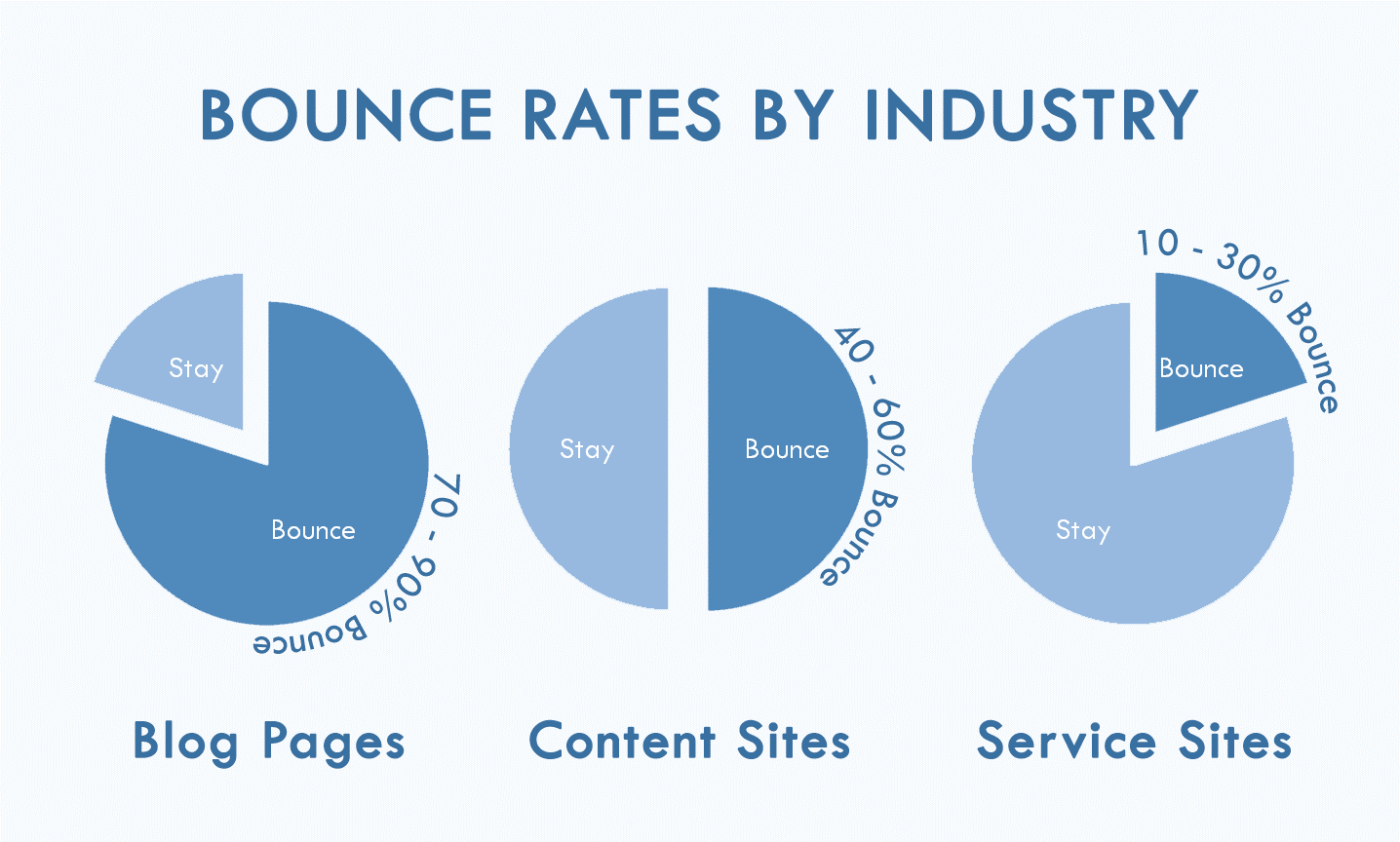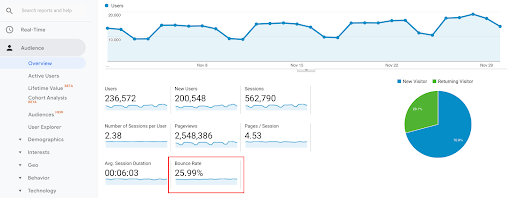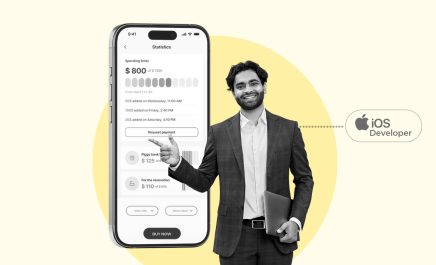7 Quick and Easy Ways to Reduce your Bounce Rate
- Sheryl Jones
- October 19, 2021
- 6 Minute Read

Attracting traffic to your website and maintaining a steady flow of visitors is the biggest challenge that businesses face nowadays. Search Engine Optimization (SEO) works from all aspects to ensure your website gets maximum visibility on search results. However, there are some factors that can bring down your website’s performance, even if your SEO campaigns are on point.
If you have been working hard to increase search traffic, find more leads, and get more conversions without significant results, chances are your bounce rate is too high. This means that customers who visit your website bounce off immediately, without creating any engagement or resulting in conversions.

A high bounce rate can harm your website seriously. It can also give your website a bad reputation in the eyes of Google. There are many ways bounce rates affect your traffic. But before learning about them, let’s find out more about bounce rates and what the ideal number is.
About Bounce Rate
A bounce is when a user visits your website through any landing page and leaves it without visiting any other pages on your domain or taking any other actions. The bounce rate is the percentage of all users who enter and exit your website through one page, without navigating to any other pages. Getting these numbers helps in bounce rate calculation.
A high bounce rate means that your website is not exciting or useful enough for a visitor to stick around. It may also indicate that you do not provide a positive user experience. Clearly, a high bounce rate is evidence that you need some changes in content or SEO strategy.
The ideal bounce rate is in the range of 25 to 40 percent, which is considered to be excellent. Anything between 41 to 55 percent is the average bounce rate, and 56 to 70 is higher than average. If your bounce rate goes higher than 70 percent, you are in serious trouble.
There are certain upsides to having a low bounce rate on your website.
- It boosts conversion rates and generates more revenue.
- It means you have an optimized website.
- It indicates that you are giving a good first impression to visitors, encouraging them to explore more.
- It leads to loyal customers and more sales.
- It increases brand awareness and builds reputation.

7 Easy Ways to Reduce Your Website’s Bounce Rate
In a few steps, you can reduce your website’s bounce rate and ensure users find something of value when they visit your website, which will compel them to stay longer and respond to your CTA.
Work on User Experience
Providing a positive user experience should be your top goal while designing or optimizing the website. An overall great user experience comprises many factors, which will lead to a good bounce rate.
- Your website should be responsive and well-visualized with important information.
- Your landing page must be clear in its elements and messaging.
- You should try to have a mobile app or optimize your website for the mobile screen.
- It should support varied input methods and device capabilities.
- Avoid or minimize the use of popup ads as far as possible. Popups are generally annoying to visitors and they may end up leaving if multiple popups disrupt their reading.
- Even if you use popups, make sure they are fun and gentle, not pushy or distracting.
- Your navigation menu must be clear, simple, and responsive on all pages.
Improve Site Speed
Site speed is a major factor in increasing bounce rates. It is erroneous to assume that only content can lead to people bouncing away. If you make them wait for too long before they can even reach the content, they will turn away disappointed.
If this is the case, even the best content cannot save you. Studies say that 47 percent of users expect a web page to load in less than two seconds. To ensure you reach that goal, optimize your landing pages regularly and fix any slow-loading pages on your website.
Especially for mobile sites, slow loads can lead to customer frustration and decrease in engagement. In eCommerce websites, customers often abandon their cart if the payment or order placement pages load slowly.
Conduct Targeted A/B Testing
A/B testing is when you create two different versions of the same web page and place them such that they appear to different visitors as they click on the page link or visit the website. This is most useful when you are conducting tests on the UX and attempting to lower bounce rates.
Through A/B testing, you can find out which version of the page is performing better and succeeding in retaining traffic. This way, you can make an informed decision on which web page to keep for the long term or whether to continue making design changes.
Optimize Content and Formatting
Content and formatting help to keep people longer on your website. This includes blog posts, articles, descriptions, rich material, and useful data points. However, to make the content more appealing to viewers, optimize it from a marketing standpoint as well. Focus on building connections, on-page SEO, and link building.
While presenting content, make sure you preserve its readability. Lengthy paragraphs and pages of plain text often intimidate or bore viewers, and they decide to leave. This is where formatting comes in. Include the following aspects into your content.
- Headings and subheadings
- Relevant images, screenshots, and infographics
- Bulleted lists, charts, graphs, and so on
- Bold keywords and phrases
- Interactive questions and solid conclusions
- Actionable elements

Use Graphics and Videos for Engagement
Visual messaging stays in the human mind longer than anything else. Add images, videos, and any related graphics wherever possible in your web pages. Invest in visual elements to create an engaging page and grab the attention of visitors.
Videos can especially work wonders in this aspect. Use a video as a background addition or with your CTA. Include music, audio, animation, narration, and story-boarding, wherever applicable. In case of images, whether they are stock photos or original images, ensure they are of high quality and strategically placed.
Place a Clear CTA
After you have optimized the content and technicals of your website, seal the deal with a clear CTA (call to action). A weak CTA can make you lose traffic after all the efforts you have put in. Keep your CTA such that the visitor is compelled to at least think about taking it.
Give every element of your CTA a good thought, be it text, color, or buttons. Make sure it is interesting, catchy, and engaging. This is important because users generally form an impression about the website in the first few seconds. In this short time, you must grab their attention with your CTA.
The website bounce rate can be decreased significantly by optimizing CTA placement and attaching an honest message with it.
Improve site navigation
Think of it this way. Your visitors want to put in the least amount of effort to search for things when they visit your website. The easier you make it for them to navigate your website, the longer they will stay and then come back later too. While deciding the navigation of the website, think from the perspective of the user and test your platform.
Important menu options should be clearly visible, not hidden in drop-downs or sub-menus. The visitor should have a seamless experience when moving from one part of your website to another, without having to play a guessing game. The better your site navigation is, the higher the efforts to reduce your website’s bounce rate is likely to be.
Conclusion
High bounce rates are not an absolute doom for your website. You have to take the above steps to reduce your website’s bounce rate quickly and effectively. To keep a regular tab on your bounce rate Google Analytics can help. Analyze your website performance, identify the landing pages that see maximum bounce, and optimize them for better results.


Thank you for submitting the details!
We will keep your information safe. Feel free to contact us with any questions at hello@uplers.com
Please check your email for next steps shared by Robert.
















